Fall Protection Strategies For Garland Standing Seam Roofs
Posted by Howie Scarboro - CEO Fall Protection Distributors, LLC on Dec 31st 2025
See the Roof Anchor Compatibility Chart for Garland Company Standing Seam Panels.

Who Is The Garland Company?
The Garland Company has influenced commercial roofing for more than 125 years. Founded in 1895 in Cleveland, Ohio, Garland began as a manufacturer of durable roofing materials for industrial buildings, when long service life mattered more than appearance.
In 1992, Garland expanded into standing seam metal roofing with the introduction of R-Mer Lite®. That move opened the door to additional systems such as R-Mer Span, R-Mer Loc, and R-Mer Shield, each developed to address specific architectural and structural demands. Over time, Garland has built a global footprint and a comprehensive portfolio that now includes metal roofing, waterproofing, vegetative roofing, and complete building-envelope solutions.
Garland standing seam roof systems reflect decades of refinement, testing, and real-world installation feedback. That same level of precision is exactly why compatible fall protection matters on these roofs.
Why Compatible Fall Protection Matters on Garland Standing Seam Roofs
Non-penetrating fall protection protects workers while preserving Garland's engineered roof systems.
Garland standing seam roof panels rely on floating roof panels and concealed attachment methods to achieve their weather resistance and long-term performance. Drilling into the panels introduces hidden leaks, restricts thermal expansion, and can void warranties.
Non-penetrating fall protection systems solve that problem when selected correctly. The SSRA1 Standing Seam Roof Anchor attaches to compatible steel seams using 12 non-penetrating set screws. Those set screws lock the anchor in place without crushing or altering the seam, allowing the roof to expand and contract as intended.
Once installed, the system scales to match the job. SSRA2 Adjustable Roof Jack Adapters mount on top of SSRA1 anchors and adjust for varying seam heights and roof pitches, allowing crews to install walk boards when stable footing is required. SSRA3 Anchor Plates also mount over SSRA1 anchors and adjust to fit most standing seam panel widths from 12 to 24 inches, creating attachment points for horizontal lifelines.
For temporary multi-worker protection, the SSRA HLL 100-foot Temporary Horizontal Lifeline Kit combines SSRA3 Anchor Plates with a 100-foot kernmantle rope lifeline. This setup allows up to two workers to stay continuously tied off while moving across the roof, all without penetrating the panels. When long-term access is required, the Super Anchor 120-foot Permanent Horizontal Lifeline Kit provides a different solution, using non-penetrating seam clamps, five-inch galvanized steel riser posts, and galvanized steel cable to create a permanent lifeline system suitable for ongoing maintenance.
On steeper Garland roofs, ridge-mounted protection is critical. The Ridge Pro Steep Assist provides a 100-percent tie-off from the ladder to the ridge and back down again. Workers install it from the ground using an extension pole, establishing a secure tie-off point before stepping onto the metal surface. The following sections break down Garland's standing seam panels and identify the most compatible fall protection solutions for each profile.
R-Mer Span T-Panels (SSRA Compatible)
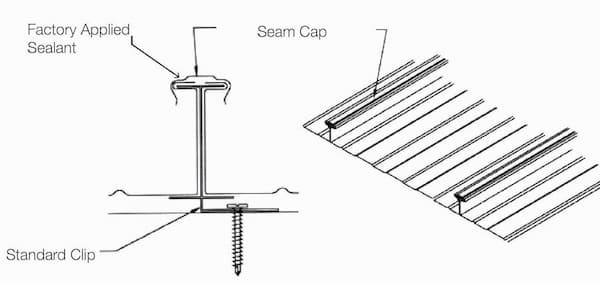
Garland's R-Mer Span T-Panel is a structural standing seam system designed for projects where strength and weather performance matter.
The panel uses a 2-3/8-inch vertical seam with formed mesas across the flat. This detail reduces visual distortion and helps control oil canning on long roof runs. That profile also contributes to consistent water shedding on large commercial buildings. See the Roof Anchor Compatibility Chart for Garland Company R-Mer Span T-Panel Standing Seam Panels.
R-Mer Span panels can be installed on slopes as low as ¼:12, making them a strong option for retrofit projects and low-slope new construction. Panel widths of 12, 16, or 18 inches pair with a continuous 16-gauge clip system that allows unrestricted thermal movement across long runs. Garland manufactures this system in 22- and 24-gauge steel, as well as aluminum, copper, stainless steel, and zinc options for specialized applications. Independent testing confirms strong resistance to wind uplift and moisture intrusion, including ASTM E1646 performance at pressures exceeding many comparable systems. Warranty options range from 20 to 30 years, depending on the material and finish.
Curving is available for this panel profile, introducing additional fall-protection considerations.
Fall Protection for R-Mer Span Panels
On 22- and 24-gauge steel R-Mer Span panels, seam-mounted fall protection provides secure anchorage without interfering with the roof's thermal expansion.
SSRA1 Seam Anchors clamp to the seam using non-penetrating set screws, creating reliable single-worker tie-off points. Optional SSRA adapter plates can expand the capabilities of the SSRA1 anchor, increasing productivity on standing seam roofs.
When stable footing is required, SSRA2 Adjustable Roof Jack Adapters mount on top of SSRA1 anchors and adjust for seam height and roof pitch, allowing crews to set walk boards without drilling into the roof. For multi-worker access, SSRA3 Anchor Plates mount over SSRA1 anchors and adapt to panel widths from 12 to 24 inches, serving as attachment points for temporary horizontal lifelines. Both the SSRA HLL 100-foot temporary kit and the Super Anchor 120-foot permanent horizontal lifeline kit are compatible with this setup, depending on whether the project requires short-term installation access or long-term maintenance tie-off.
On aluminum, copper, or other non-steel R-Mer Span panels, and on roofs with a pitch between 6:12 and 12:12, ridge-mounted protection is preferred. The Ridge Pro Steep Assist establishes a secure tie-off point at the ridge without contacting the panel surface, keeping workers protected while avoiding damage to softer substrates.
R-Mer Span panels can be curved to meet the architectural requirements of shaped roof designs. Curved panel installations should be evaluated on-site by a trained fall protection professional.
R-Mer Loc Snaplock Panels (SSRA Compatible)

A snaplock standing seam system engineered for watertight performance on architectural and retrofit roof designs.
Garland's R-Mer Loc panel system targets projects that demand architectural detail without sacrificing weather performance. The snaplock seam design pairs a 1-3/4-inch vertical rib with a heavy 18-gauge, one-piece clip that spans efficiently over open framing or solid substrates. This configuration makes R-Mer Loc a popular choice for mansards, parapets, and reroofing applications where clean lines and reliable drainage matter. See the Roof Anchor Compatibility Chart for Garland Company R-Mer Loc Snaplock Standing Seam Panels.
An internal gutter and anti-siphon feature built into the seam helps manage wind-driven rain, reducing the risk of water intrusion at panel joints. Concealed clips allow controlled thermal movement while keeping the fasteners protected beneath the panel surface. Garland manufactures R-Mer Loc panels in 22- and 24-gauge G-90 galvanized steel, as well as .040 aluminum, offering flexibility for both performance and appearance.
Panel widths of 12, 16, and 18 inches support a range of design layouts, with factory-formed lengths available up to 50 feet. Depending on substrate conditions, installation can reach slopes as low as 1.5:12. Extensive testing backs the system, including UL 90 wind uplift ratings, a Class A fire rating, and ASTM air and water performance approvals.
Fall Protection for R-Mer Loc Panels
On 22- and 24-gauge steel R-Mer Loc panels, seam-mounted fall protection provides secure access without disturbing concealed clips or drainage features.
SSRA1 Seam Anchors lock onto the raised seam using 12 non-penetrating set screws, creating dependable tie-off points while keeping the panel surface intact. With the d-ring removed, the SSRA1 is compatible with various SSRA adapters, expanding the system's functionality.
When crews need stable footing for installation or service work, SSRA2 Adjustable Roof Jack Adapters install over SSRA1 anchors and adjust to both seam height and roof pitch, allowing walk boards without penetrations. For expanded work zones, SSRA3 Anchor Plates mount over SSRA1 anchors and accommodate panel widths from 12 to 24 inches, serving as attachment points for temporary horizontal lifelines. The SSRA HLL 100-foot temporary horizontal lifeline kit supports short-term access for two workers. In contrast, the Super Anchor 120-foot permanent horizontal lifeline kit offers a long-term solution using non-penetrating seam clamps, galvanized steel cable, and 5-inch riser posts.
On aluminum panels or roofs with a pitch between 6:12 and 12:12, ridge-mounted protection is the best option. The Ridge Pro Steep Assist establishes a tie-off point at the ridge before workers step onto the roof, maintaining continuous protection without contacting or penetrating the panel surface.
R-Mer Shield Panels (SSRA Compatible with Test Fit)
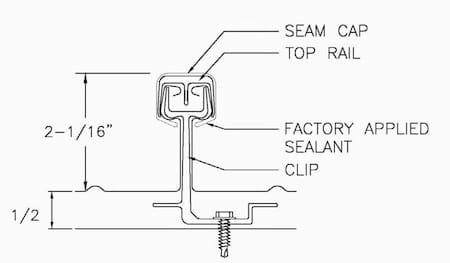
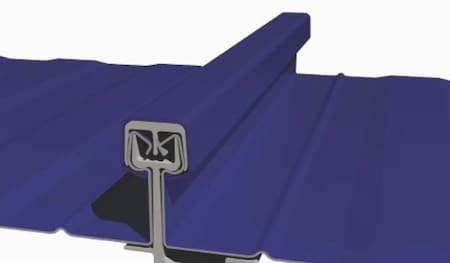
Garland's R-Mer Shield panels focus on structural strength where wind resistance matters most.
This system uses a 2-1/16-inch vertical seam paired with an extruded aluminum clip and top rail assembly, allowing unrestricted thermal movement without stressing the panel or fasteners. That design gives R-Mer Shield its reputation for stability in high-wind regions and demanding environments. See the Roof Anchor Compatibility Chart for Garland Company R-Mer Shield Snaplock Standing Seam Panels.
R-Mer Shield installs over open purlins on slopes as low as 1/4:12, making it well-suited for both retrofit projects and new construction. Panel widths of 12.75, 16.75, and 18.75 inches are available to meet architectural specifications. Panel material options range from 20-, 22-, and 24-gauge G-90 galvanized steel to aluminum, zinc, copper, and stainless steel. Warranty options typically span 30 to 40 years, depending on the selected material and finish.
Fall Protection for R-Mer Shield Panels
Seam-mounted and ridge-based fall protection options protect workers without disrupting the top-rail seam design.
Because the R-Mer Shield seam uses a top-rail box profile, anchor compatibility depends on the seam's dimensions. SSRA1 Seam Anchors can be test-fit to confirm proper engagement before use. Once verified, SSRA1 anchors clamp securely to the seam using 12 non-penetrating set screws, creating reliable tie-off points without deforming the panel.
For crews that need level working surfaces, SSRA2 Adjustable Roof Jack Adapters install over SSRA1 anchors and adjust to both seam height and roof pitch, allowing workers to mount walk boards without drilling. SSRA3 Anchor Plates then expand the system by supporting temporary horizontal lifelines and accommodating panel widths from 12 to 24 inches. For short-duration work, the SSRA HLL 100-foot temporary horizontal lifeline kit provides mobility for two workers. For buildings that require ongoing access, the Super Anchor 120-foot permanent horizontal lifeline kit uses non-penetrating seam clamps, galvanized steel cable, and 5-inch riser posts to create a long-term solution.
On aluminum, zinc, or other non-steel substrates, or on roofs with a pitch between 6:12 and 12:12, ridge-mounted protection is the safer option. The Ridge Pro Steep Assist establishes a tie-off point at the ridge before workers step onto the roof, maintaining continuous protection without contacting the panel surface or seam system.
Standing Seam Metal Roof Anchor 22-24 Gauge Panel Compatibility For Garland Company
| R-Mer Span T-Panel (22 Ga.) | R-Mer Span T-Panel (24 Ga.) | R-Mer Loc (22 Ga.) | R-Mer Loc (24 Ga.) | R-Mer Shield (22 Ga.) | R-Mer Shield (24 Ga.) | |
|---|---|---|---|---|---|---|
SSRA 1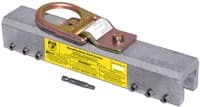 |
YES | NO | YES | NO | Test Fit | NO |
SSRA1 Nylon Tip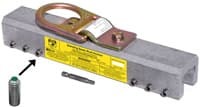 |
YES | YES | YES | YES | Test Fit | Test Fit |
SSRA2 Roof Jack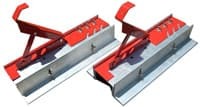 |
YES | YES | YES | YES | Test Fit | Test Fit |
SSRA3 Anchor Plate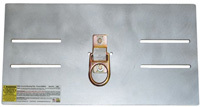 |
YES | YES | YES | YES | Test Fit | Test Fit |
The Ridge Pro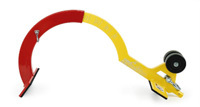 |
YES | YES | YES | YES | YES | YES |
Contact Us for Expert Standing Seam Fall Protection Advice
For expert guidance on standing seam roof anchors, lifeline kits, and fall protection systems that protect both your crew and your panels, contact us today at 863-703-4522 or visit www.StandingSeamRoofAnchor.com. Our safety specialists can help you match the right non-penetrating anchor to your specific roof profile and slope. Let's make your next metal roofing project safe, compliant, and built to last. For continued learning, download OSHA's 48-page Fall Protection Manual and our free Anchor Inspection Form once you've selected the ideal anchors for your roof system. Together, we'll help you stay ahead of OSHA standards while preserving your roof's weather-tight seal.
Safety Tips For Standing Seam Roofs
Use Specialized Anchor Systems for Standing Seam Roofs
Fall protection that grips the seam without puncturing the panel keeps crews protected while allowing the roof to expand and contract as intended. Using non-penetrating seam anchors designed for standing seam roofs prevents crushed seams, damaged clips, and performance issues that may not appear until years later. Using anchors with set screws can protect the seams from crushing.
Promote a Culture of Safety
The safest job sites are those where safety conversations take place before the workday begins. Brief daily check-ins about roof layout, weather conditions, access points, and tie-off locations help crews spot problems early. When workers feel comfortable speaking up, minor issues get corrected before they become serious incidents.
Prioritize Ladder Safety Training
Poor ladder angles, soft ground, and unsecured tops can make ladder climbs the most dangerous task on a roofing job. Reinforcing proper setup, stable footing, and three points of contact reduces exposure during this critical phase of the workday.
Equip Workers with High-Quality Safety Gear
Harnesses that fit correctly and SRLs that engage smoothly allow workers to focus on footing and task execution instead of adjusting equipment. Ill-fitting gear leads to fatigue, restricted movement, and distraction on smooth metal panels. OSHA reinforced in 2025 that employers must provide appropriately sized equipment, making fit a compliance issue as much as a comfort one.
Develop OSHA-Compliant Safety Plans
Large Garland roof systems often include multiple elevations, long panel runs, and mixed access points. A written safety plan outlines anchor placement, lifeline routing, access methods, and rescue responsibility before work begins. Updating the plan as conditions change keeps crews aligned when worker coordination matters most.
Set Up Protective Guardrail Barriers for Work Zones
Guardrails provide passive protection without relying on worker action. Installed around skylights, roof edges, and equipment zones, they create clear boundaries that crews respect naturally. Guardrails reduce exposure in high-risk areas and allow workers to stay focused on installation or service tasks.
Ensure Proper Footwear for Stability
Metal roof surfaces can change quickly due to dew, dust, or temperature shifts. Boots with aggressive tread, firm ankle support, and non-slip soles help workers maintain balance while carrying tools or moving between tie-off points. Footwear remains one of the simplest and most effective layers of fall prevention.
Install Permanent Roof Anchor Systems
Many Garland buildings require ongoing access for inspections, HVAC service, or future upgrades. Permanent horizontal lifeline systems establish fixed lifelines for maintenance crews. These systems reduce setup time, limit the repeated handling of temporary equipment, and support safer long-term maintenance practices throughout the roof's life.
Encourage the Use of Trauma Straps
Once a fall arrest system stops a fall, suspension trauma becomes the next concern. Trauma straps allow a suspended worker to shift weight, relieve leg pressure, and maintain circulation while rescue procedures are activated. Lightweight and easy to carry, they play a critical role when response time matters.
Consult Experts for Curved Metal Panels
Curved standing seam roofs introduce attachment challenges that standard anchors may not address. A fall protection professional experienced with curved metal systems can evaluate the roof system and anchorage options before work begins. That review protects workers, preserves the roof system, and prevents costly mistakes tied to improper anchor selection.
Disclaimer
The views, recommendations, and information presented in this blog are solely those of the author and do not necessarily reflect the opinions or positions of the featured panel manufacturer, its brands, subsidiaries, or parent companies. Customers are strongly encouraged to contact the roof panel manufacturer directly for inquiries regarding fall protection compatibility with their products and to address any potential warranty issues that may arise after installing our products.

